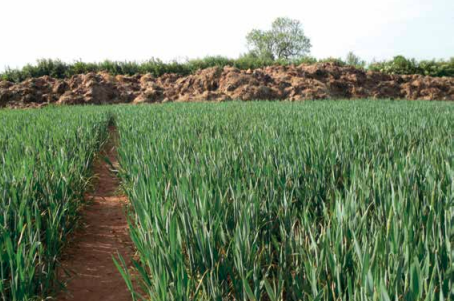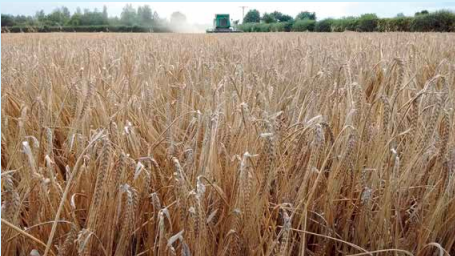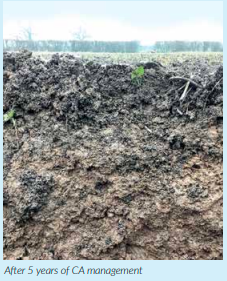We are all in need of healthy soils but how can we create that magical organic matter cocktail,
Dr James Holmes from AHDB shares some simple advice on what to look for

Soil organic matter is a mysterious substance with legendary qualities yet practical guidance on how to manage it has been thin on the ground. A series of research projects funded by farmers and growers through the AHDB has shed light on this extraordinary material.

What is soil organic matter?
Soil organic matter (SOM) includes all living and dead plant and animal material. It includes the roots of newly sown and developing crops, stubble, manures and substances made and secreted by roots and soil organisms.
There are three main forms of SOM, at progressive stages of decomposition.
1. Fresh plant residues and small living organisms
2. Decomposing material, often called active organic matter
3. Humus, often referred to as stable organic matter
All SOM contains carbon but it also contains other plant nutrients such as nitrogen, phosphorus, potassium, sulphur and micronutrients.

Does it really matter?
Applying organic materials, such as farmyard manure or compost is thought to improve soil structure by feeding soil organisms such as earthworms. However, results of historical trials have been ambiguous because materials such as compost supply not only organic matter but also nutrients that crops respond to.
Trials at Rothamsted Research have shown that applying farmyard manure can improve barley grain and straw yields within two years. Penetrometer assessments suggest yield is increased by improving root growth and exploration. It’s thought that organic matter added to soil feeds soil organisms that in turn improve the structure of the soil.
To help farmers improve soil management and benefit from soil organic matter, AHDB set up a series of trials from 2012 to 2016. The trials measured yields in response to fertiliser nitrogen with and without additions of either digestate, compost or farmyard manure. Comparisons were made between conventional tillage and reduced tillage as well as the ways in which different crops and crop rotations were affected by additions of organic matter.
Over the four years of trials, yields were consistently higher when an organic material was applied to a crop, as opposed to only an application of the same amount of nitrogen. This showed that organic matter, be that digestate, compost or farmyard manure, increased the yield of the crop by providing benefits in addition to nitrogen. Measures of the draft force needed to plough the soil suggest that organic materials improved yields by not only supplying nitrogen but by improving soil structure. Interestingly, a set of long-term trials have shown that applying organic materials mitigates the effects of soil borne disease and help maintain yield consistency from year to year. This resilience is important given the increasing fluctuations in weather that we are experiencing.
How do I measure soil organic matter?
Levels of SOM change relatively slowly so should only be measured every 3-5 years alongside routine analysis of soil phosphorus, potash and magnesium levels. A measurement of SOM matter is not normally included in the price of a routine soil analysis so it is important to tell the lab you would like it to be included. A lab will measure the percentage of SOM in your soil sample using either the loss on ignition or Dumas method. It does not matter which lab/method is used but as with all analyses it is important to use the same lab in the future so that you can compare results.
How much soil organic matter should I have?
Levels of SOM are measured as a percentage. Currently there are no agreed targets or ideal levels of SOM for different soil types. However, AHDB is testing a new system and has published preliminary SOM targets for different soil types, across different rainfall areas of England and grass or arable farms. Visit www.ahdb.org.uk/greatsoils where you can read a factsheet on Measuring and Managing Soil Organic Matter with supplementary information on appropriate levels of organic matter in soil.

How can I increase levels of soil organic matter?
Disruption of soil aggregates during tillage usually results in decomposition of SOM and a decrease in the percentage the soil contains. Where levels of SOM are low it can be increased by including cover crops in the rotation or by applying organic materials such as compost or farmyard manure.

Although the benefits of applying organic matter are becoming increasingly clear it is important to consider the cost of organic materials. AHDB research has shown that above the value of the nutrients it contains, it is rarely economic to spend more than a further £30/t/ ha (dry matter) on an organic material, including haulage and spreading.
Further Information
For more information on the topics above, please visit:
• Improvement of soil structure and crop yield by adding organic matter to soil: Search “AHDB Cereals and Oilseeds Project Report No. 576”
• Organic matter and soil management: ahdb.org.uk/greatsoils
• Nutrient management guidance: ahdb.org.uk/rb209
